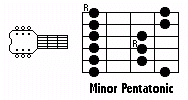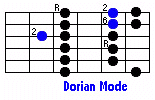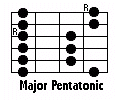Modes From the Pentatonic Scale
Most guitarists who play lead know the pentatonic scale, the box shaped, two note per string pattern that is the breeding ground for many a rock and bluesy riff. Amongst the many of us who know and use this scale, there are far less who know and can effectively use modes.
If you already have some idea of what modes are but are looking for a quick and easy way to play them on the guitar, or if you'd just like to experiment with them without detailed explinations, then read on.
For our purposes here, let's just think of modes as other scales, alternatives to the pentatonic scale. This is exactly what they are, and they provide you with a lot of other moods and colours. But more explanation on what each mode is used for we'll leave for the said upcoming article.
What I'm going to show you here, is a quick way of getting to all but one of the modes, by simply adding a few notes into the pentatonic shape. First let's just qualify something; this approach, which does work, is limited. If you want full fluency when playing modes and want to be able to play up and down the neck all around the fret board, then this short cut is not what you're after. It is a short cut.
But if what you want is just the ability to get a bit of modal playing into your rock playing, to spice up your playing with some new sounds, then this approach will get you there very quickly.
First let's agree to use what's known as the first position of the pentatonic scale as our starting point. If you are not familiar with this position (fingering pattern), then get to know it before going any further. Although shape is illustrated later on in this article, I suggest that you get very familiar with it before you attempt any of what we're about to look at.
MAJOR and MINOR
This one scale shape (the first position of the pentatonic scale), in case you didn't know, gives you two very useful scales without adding anything to it.
Most people first come across it, being used as a minor scale. In this form, it sounds great for playing over minor chords. Its also great for Major and dominant chords (a common type of dominant chord is a 7th chord), and over these you'll get a strong bluesy sound.
The fact that you get a bluesy sound, is largely because you are using a minor scale over a major chord. (dominants are based on major chords), so there is a clash, but its a nice bluesy sounding one. To get this scale, all you do is to place the shape; so that your 1st finger E string, is on the same fret as the root of the chord you are playing over. Think of a bar chord with the root on the E string eg: C major chord at the 8th fret.
The second scale you can get with the same pentatonic shape; is the major pentatonic scale. This is another very useful scale. It sounds great over Major and dominant chords, but not over minors. You get a lot of nice sounding notes, without the bluesy sound of the minor pentatonic. To play this scale you just take the same 1st position pentatonic shape, but place it so that your 4th finger E string, is on the same fret as the root of the chord you are playing over. In other words you move the minor pentatonic shape down 3 frets and it becomes major.
It is from these two scales; the minor and major pentatonic, that we can add a couple of notes and get the modes. Below are fret diagrams, showing you how to very quickly and easily get all but one of the modes from the pentatonic shape. The notes of the original pentatonic are in black, while the added notes that turn them into the modes are in blue or red.
Note that the additions in these diagrams only cover the the top three strings. You can figure out where these added notes would be on the other strings if you like. We've given you a good head start here, but it will do you a lot of good to go through the thinking processes necessary to add in the notes on the lower strings. However, I think you'll find that its probably better to stick to adding in the mode notes on the top three strings for some time; until you really get to know what they sound like, before you go on to the lower strings. Most players who use primarily the pentatonic, stick to the top three strings for the modes.
Keep in mind that this approach is a short cut for those who want to add a bit of the modes into their playing, in a very quick and easy way. If you really want to use modes all the time (eg: you are a jazz player), then you really want to approach the whole thing from a completely different angle fingering wise. Something we'll look into in a future article. But for the 'casual mode user', this pentatonic approach saves you a lot of time and work.
The diagrams below show you how adding in just a couple of extra notes to the pentatonic, gives you all the most useful modes.
INTEVALS:
I do first have to mention just one teeny weeny bit of music theory. I've tried to avoid this as much as possible, since the point of this article is to provide you with easy hands-on access to the modes. But this little bit of theory GOES A LONG WAY!
Do you know what an interval is? All music apart from the rhythm, is based on intervals. An interval is just the distance between your root note and any other note. Every chord and every scale has a root note. Chord is just a set of intervals played against a root note, a scale is the same thing except you play the notes one at a time. There are eleven intervals, each is a semitone further away from the root note, until you reach the root note again an octave higher. Here is a list of the intervals:
Root, b2, 2, b3, M3, 4, +4, 5, b6, 6, b7, M7, Root
In a way, this is the key to everything - learn it!
Now on to the fingering.
We start with the first position of the minor pentatonic:

Then, by adding in an interval of a 2nd and a 6th (blue dots), we get the dorian mode (a colourful jazzy minor sound over minor or dominant chords):

Next, we get the Aeolian mode. Notice that we keep the interval of a 2nd in there, but we put in a b6 instead of a 6. (This is a sadder minor scale popular in both rock and contemporary jazz, sounds great over minor or dominant chords):

Now the Phrygian mode. This is known as the 'Spanish' scale and it is used extensively in Spanish music. Here, we add in a b2 and a b6 to the minor pentatonic (This works best over dominant chords):

Next let's see what modes we can get from the major pentatonic scale. Remember, you use the same fingering shape as for the minor pentatonic, but you move the shape down three frets; so that your 4th finger is on the root of the chord you playing over. Notice how the roots fall in different parts of the shape:

First let's just get a normal every day major scale out of it. This is easily done by adding in the interval of a major 7, and a 4th (red dots). (This scale works over basic major chords its also known as the Ionian mode). Tip: notice how the fingering pattern for the major scale is the same as that of the Aeolian mode in the minor pentatonic. When you've had a look at all of these shapes, you'll see that all 6 modes comprise of only 3 shapes!

Next we'll produce the ever popular Lydian mode. We keep the Major 7th interval, but we add a sharp 4 instead of the normal 4 we had in the major. (this scale is popular in modern rock (Hendrix also used it) and jazz, and it works well over major chords. It works better than the major scale to most people's ears, over Major 7th chords):

Finally, if we add in a b7 and a normal 4th, we get the Mixolydian mode. (this works well for dominant chords, and is popular in rock and jazz, sometimes called the 'melodic rock scale'):

Mark Wingfield



